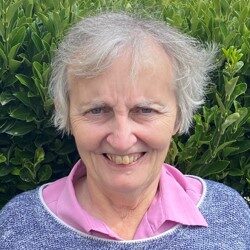 Margaret Corkery and Helena, a survivor
Margaret Corkery and Helena, a survivor
During this Retreat the Providential hand of God was visible in the unexpected and unprepared for events. Meeting the survivor Helena was humbling. It highlighted the unique importance of the individual and the awareness of resilience, as well as our need to listen and ponder.
German precision and their focus on regularity were evident in the buildings of Auschwitz 1. Their use of space, made visible the hustle and bustle of camp life. Their false promise and sarcastic use of the sign “work will make you free” emphasised the despair, cruelty and abuse of power. This was further highlighted in the “Standing/Gathering” areas and the “Wall of Death.” A chilling place. Human nature was stripped to its depth, of total degradation.
The other side of Auschwitz 1 was St. Maximilian Kolbe who epitomised empathy, understanding and the need for action. He illustrated the other side of the human spirit and the “Power of One.” He was the last to die in the cell and then by lethal injection; this means that none of the other prisoners had to die alone. He made the cell a redemptive and caring place where prayers and hymns were sung.
 Helena (wearing green skirt) praying for her mother at the crematorium
Helena (wearing green skirt) praying for her mother at the crematorium
Birkenau/Auschwitz 2 and the all-pervasive silence, touched deep within the psyche. This carried through to night prayer where the silence and inability of the group to articulate spoke volumes. This was a powerful tribute to the inner workings and depth of the experience. The vastness of Birkenau was all inspiring and yet, all within rebelled at what it stood for. The depth of human ash and its use calls to mind the sobering Lenten reminder “Dust to dust and ashes to ashes.” Here Helena epitomised the resilience of the human spirit. She stood ramrod straight and unmoving as she remembered her mother R.I.P. at Crematorium 2. As she prayed pain oozed all around.
The placard “I am delighted to be back in Auschwitz” as carried round the camp by recaptured escapees was depicted in drawings by Marian Kolodziej. It illustrates and emphasises the “Inner Auschwitz” struggle which he completed when he drew “The old man carrying the young man out of Auschwitz.” This integration and redemptive process needs to take place in us too.
As we walked the “Way of the Cross” in Birkenau the old idea of “Stations” was shattered and a seismic movement of change happened as we were faced with the real life experience of the modern stations. This became an awareness and the raising of consciousness of today’s Auschwitz in Rwanda, Kosovo, Aleppo and the ashes of the migrants in the depths of the ocean to name but a few.
As we carry ourselves out of our own Auschwitz we need to take time to ponder and realise, that while we understand life backwards, we live life forwards. Physical nearness and human distance was graphically captured at the back entrance to Birkenau. This challenges us to free ourselves consciously to be truly human with all the soul searching that entails.
As we move reflectively forward, the question arises as to how to give shape, to the challenge to act, to make a difference here and now.
Bonaventure Higgins rsm
South Central Province




